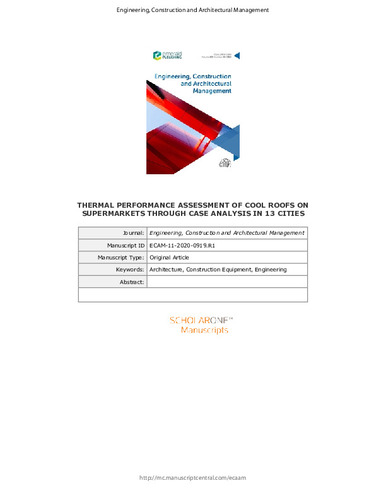Thermal performance assessment of cool roofs on supermarkets through case analysis in 13 cities
Autor(es) y otros:
Palabra(s) clave:
Cool roof
Energy efficiency
Thermal comfort
Sustainable cities
Fecha de publicación:
Versión del editor:
Citación:
Resumen:
Purpose: This paper aims to study the use of cool roof technology to avoid unnecessary energy consumption in supermarkets. This will allow to reduce and even cancel the heat absorbed by the roofs, transferring it to the buildings and thus, creating more sustainable cities. Design/methodology/approach: Thirteen real supermarkets with cool roofs were analysed in Australia, Canada, the USA and Spain. An analysis of so many supermarkets located in different parts of the world with different climatic zones has allowed an inductive analysis, obtaining real data of energy consumption associated with the air conditioning installations for a year with and without implementing the cool roof technology. Findings: The paper provides insights on how the use of cool roof managed to reduce the need for energy for heating, ventilating and air conditioning by between 3.5 and 38%. Additionally, this technology reduces the annual generation of carbon dioxide (CO2) emissions per square meter of supermarket up to 2.7 kgCO2/m2. It could be an economical technology to apply in new and old buildings with a period of average economic recovery of four years. Research limitations/implications: Because of the chosen research approach, the research results may be generalisable. Therefore, researchers are encouraged to test proposals in construction with other uses. Practical implications: The paper includes economic and environmental implications for the development of cool roof technology and smooths the way for its implementation to increase energy efficiency in commercial buildings. Originality/value: This paper is an innovative contribution to the application of cool roof technology as a source of energy savings in commercial construction through the analysis of supermarkets located in different countries with different climate zones. This will help other researchers to advance in this field and facilitate the implementation of the technology.
Purpose: This paper aims to study the use of cool roof technology to avoid unnecessary energy consumption in supermarkets. This will allow to reduce and even cancel the heat absorbed by the roofs, transferring it to the buildings and thus, creating more sustainable cities. Design/methodology/approach: Thirteen real supermarkets with cool roofs were analysed in Australia, Canada, the USA and Spain. An analysis of so many supermarkets located in different parts of the world with different climatic zones has allowed an inductive analysis, obtaining real data of energy consumption associated with the air conditioning installations for a year with and without implementing the cool roof technology. Findings: The paper provides insights on how the use of cool roof managed to reduce the need for energy for heating, ventilating and air conditioning by between 3.5 and 38%. Additionally, this technology reduces the annual generation of carbon dioxide (CO2) emissions per square meter of supermarket up to 2.7 kgCO2/m2. It could be an economical technology to apply in new and old buildings with a period of average economic recovery of four years. Research limitations/implications: Because of the chosen research approach, the research results may be generalisable. Therefore, researchers are encouraged to test proposals in construction with other uses. Practical implications: The paper includes economic and environmental implications for the development of cool roof technology and smooths the way for its implementation to increase energy efficiency in commercial buildings. Originality/value: This paper is an innovative contribution to the application of cool roof technology as a source of energy savings in commercial construction through the analysis of supermarkets located in different countries with different climate zones. This will help other researchers to advance in this field and facilitate the implementation of the technology.
ISSN:
Ficheros en el ítem




